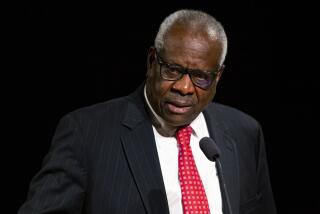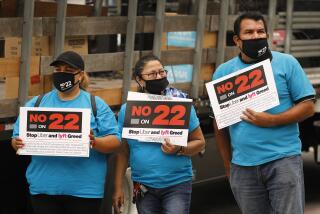Court to Decide Who Pays for Taking a Risk
SAN FRANCISCO — A water-skier gliding along barefoot and backward strikes his head on a tree branch. A woman loses her finger after it is smashed in an impromptu, co-ed touch football game. A sandlot softball player loses an eye after he is hit by a throw. A vacationer at a resort breaks a collarbone when she is thrown by a horse.
To some, such misfortunes ought to be chalked up to the inherent risks of recreational sports. Instead, these injured parties went to court--filing damage suits blaming someone else as negligent.
Whether such lawsuits will survive is up to the California Supreme Court. The justices are to decide this summer if defendants may escape financial responsibility because the people who sued had assumed the risks that led to their injuries.
The court’s decision could affect not only participants in recreational sports but those who face risks on the job. The vigorous legal debate surrounding the case has raised broad questions about freedom of choice and personal responsibility.
Attorneys for defendants say basic fairness requires that individuals be held accountable for risks they knowingly and voluntarily assume. Allowing them to collect damages from others would discourage people from providing or joining in recreational pursuits and burden courts with meritless lawsuits, these lawyers say.
“We want to encourage a certain amount of risk-taking by people,” said Fred J. Hiestand, attorney for the Assn. of California Tort Reform in the case before the court. “That’s what made this country great.”
Lawyers for plaintiffs reply that even when injured parties are at fault to some degree, they should be able to collect damages from others who failed to perform competently and responsibly.
Ian Herzog of Santa Monica, president of the California Trial Lawyers Assn., said a ruling preventing injured parties from obtaining damages would be a severe setback.
“It could have a tremendous impact,” said Herzog. “It would allow a wrongdoer to get off scot-free, even though he was partially or totally at fault.”
The dispute has emerged in the wake of a major shift in California civil liability law that took place 16 years ago. Before then, under the “all-or-nothing” doctrine of contributory negligence, injured people who were only partly responsible for the harm they suffered were barred from suing another party for negligence.
In 1975, the state Supreme Court adopted the doctrine of comparative negligence, saying that damages must be apportioned according to the degree of fault of the various parties. Thus, a plaintiff who sought $100,000 in damages, but was found 50% at fault, would collect $50,000.
Until then, defendants could win dismissals of a suit if the plaintiff voluntarily assumed the risk of a known danger. Since the decision, lower courts have disagreed over whether that defense remains valid after the adoption of comparative negligence. Plaintiffs’ lawyers say assumed risk is no longer a complete defense, but defense lawyers say it is.
If the defense survives, businesses and individuals who are sued will be able to obtain dismissals before trial, avoiding large jury awards or costly settlements. If such a defense does not survive, it will be easier for plaintiffs to take their cases to trial, and, even if partially at fault, win damages from a negligent defendant. In many cases, millions of dollars would be at stake.
The debate is being waged amid calls from critics for the courts to curb suits by litigants who have been hurt while taking obvious and sometimes foolish risks.
In a recent speech before the Lawyers Club of San Francisco, Judge Alex Kozinski of the U.S. 9th Circuit Court of Appeals said the legal system was effectively subsidizing “irresponsible and self-destructive behavior.”
Kozinski cited a 1987 ruling by a federal appellate panel allowing a man to sue the government for severe injuries he received while allegedly stealing copper cable at a naval base. The judge also pointed to the case of anti-war activist Brian Willson, who obtained a $920,000 settlement from the government after he lost both legs when struck by a munitions train while sitting on the railroad tracks at Concord Naval Weapons Station.
“You may not know what time a train is coming but you can predict with a fair degree of accuracy the path of a train,” Kozinski said. “This is not just assumption of risk, but assumption of certainty.” The courts should apply the “Toyota Principle,” he said. “ ‘You asked for it, you got it.’ ”
The case the justices have chosen to settle the issue in California involves a 1983 incident in which Larry C. Ford was seriously injured when he collided with an overhanging tree limb while water-skiing backward in a narrow channel in the Sacramento River delta.
Ford sued Jack Gouin, the driver of the boat that was towing him, for negligence. Gouin obtained a dismissal of the suit on grounds that Ford had implicitly but clearly assumed the risk of injury, thus freeing the driver from liability. A state Court of Appeal upheld the dismissal in a 2-1 decision last year.
In arguments before the high court last month, Ford’s lawyer, Eric D. Carlyle of San Jose, contended that the water-skier had relied on the driver to avoid hazards and that Gouin was liable for failing to exercise reasonable care.
“One who commits negligence should be responsible for damages caused by that negligence,” Carlyle told the justices.
Gouin’s lawyer, Roberta M. Knapp of San Jose, argued there was no need for the case to go to a jury because Ford had knowingly and voluntarily assumed the risk of injury.
“(Ford) knew exactly what he was doing,” said Knapp. The skier, she said, had accepted the inherent dangers of traveling “backward and barefoot down a narrow, tree-lined slough at 35 to 40 m.p.h.”
Some court members appeared concerned with the impact of the case on the recreation industry. Justice Armand Arabian suggested that allowing suits in such circumstances would force recreation sponsors to obtain written waivers from all participants or face financial disaster.
“Isn’t public policy served by allowing summary (dismissals) in appropriate cases?” asked Arabian. “If every person helping someone else enjoy recreation . . . is subject to litigation, we will ultimately put everyone out of business, won’t we?”
“In a capitalist society, I don’t think so, your honor,” replied Carlyle. In cases where the parties are acquainted, said the attorney, “friendship is not an excuse for negligence.”
The issue has drawn wide interest in business and legal circles, with the California Chamber of Commerce, K&K; Insurance Group Inc., California Ski Industries Assn. and Assn. of California Tort Reform backing the defendant. The California Trial Lawyers Assn. is supporting the plaintiff.
The justices’ decision in the Ford case is expected to determine the fate of several disputes involving recreational injuries that are pending before the court. For example:
* Mark Krol lost an eye in 1988 after being hit in the face by a throw while running the bases in a slow-pitch softball game in Contra Costa County. Krol brought suit against the second baseman who was throwing the ball to first base to complete a double play. A state Court of Appeal rejected the suit, saying the possibility of being hit by a ball was an inherent risk of the game.
* Kendra Knight eventually lost a little finger after it was stepped on during a spontaneous touch football game at a home in Vista during halftime of the 1987 Super Bowl. Knight sued a male participant who bumped into her as he sought to intercept a pass. An appellate court upheld dismissal of the suit, noting that Knight had voluntarily joined in a game she knew carried risks.
* Charlene Harrold suffered a broken collarbone when she was bucked off a horse she was riding at a recreational camp near Lake Hughes in 1983. Harrold sued the resort that provided the horse, charging that its employees failed to warn her that the horse had earlier thrown another rider. A state appeals panel upheld the suit, saying the defendants had not refuted claims that the woman was unaware of the horse’s “propensity to be spooked.”
The question of assumption of risk has been raised as well in a variety of job-related cases pending before the justices. The court has been asked:
* To allow the survivors of David Hacker to bring a wrongful death suit against Glendale and others. Hacker was trimming a tree at a private residence when he was electrocuted by a city-owned high voltage power line passing through its branches. The suit charged that the city negligently allowed the branches to intrude on the line. A state Court of Appeal upheld dismissal of the suit, finding that Hacker, an experienced gardener and tree-trimmer, was aware of the danger and had assumed the risk.
* To allow the family of Terry Lee Sudlow a new trial in an effort to collect damages from a southeast Los Angeles County store for wrongful death after Sudlow, an armored car service guard, was shot and killed on the store premises. The suit charged that the store was negligent in not training its security staff in preventing criminal acts. A jury found that the store was negligent but denied damages to the family because Sudlow had assumed the risk of injury or death in his employment.
More to Read
Sign up for Essential California
The most important California stories and recommendations in your inbox every morning.
You may occasionally receive promotional content from the Los Angeles Times.










